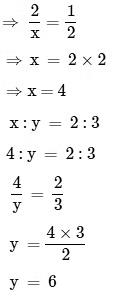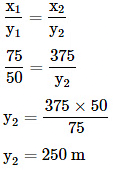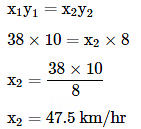Class 8 Maths Chapter 11 Important Question Answers - Direct and Inverse Proportions
Q1: Which of the following quantities vary directly or indirectly with each other
(a) Number of pens and their cost
(b) Distance travelled (at constant speed) and petrol used.
(c) Number of men available and time taken to do a job.
(d) Area of land and its price.
(e) Wages y and hours of work x.
Ans:
(a) As pens increase, cost increases– Direct variation.
(b) As distance travelled increases, the amount of petrol increases– Direct variation.
(c) Number of men decreases, time taken increases– Inverse variation.
(d) If the price per unit area of land is constant, then the price varies directly with the area- Direct variation.
(e) Wages vary directly with the hours of work if the hourly wage rate is constant- Direct variation.
Q2: The cost of 5 metres of a particular quality of cloth is Rs.210. Find the cost of 2 metres of cloth of the same type.
(a) Rs. 84
(b) Rs. 60
(c) Rs. 90
(d) Rs. 100
Sol: Cost of 5 metre cloth = Rs. 210
Cost of 1 metre cloth = 210/5
= 42
Thus, cost of 2 metre cloth
= 2 × 42
= Rs. 84
Q3: If XY = 10 then X and Y vary _____ with each other.
Ans: Inversely
This is because as X increases, Y must decrease to keep the product XY constant at 10, and vice versa. The relationship is defined by the equation
Q4: In the table state whether x and y vary directly or indirectly. Ans: Since, as ‘x’ increases, ‘y’ also increases.
Ans: Since, as ‘x’ increases, ‘y’ also increases.
Therefore, ‘x’ and ‘y’ vary directly.
Q5: If 32 men can reap a field in 15 days. In how many days can 40 men reap the same field?
Sol: This situation is inverse variation (less men, more days)
Let x = men, y = no. of days x1 = 32, y1=15 x2 = 40, y2 = ?
Formula is x1y1 = x2y2
(32)(15) = (40)y2
y2 = 32×15 / 40
y2 = 12
Therefore, number of days =12
Q6: Find the value of x and y if x : y = 2 : 3 and 2 : x = 1 : 2.
Sol: Given: 2 : x = 1 : 2
Q7: The scale of a map is given as 1 : 80000000. Two places A and B on the map are 3 cm apart. What is the actual distance between A and B? If C and D are 3200 km apart, then find the distance between them on map?
Sol: Given: scale of map = 1 : 80000000
Thus, 1 unit on map shows 80000000 units in the real world.
If A and B are 3 cm apart on map,
Actual distance = 3cm × 80000000
= 240000000
= 2400 km
If C and D are at 32km apart, then
3200km = 3200 × 1000 × 100cm
= 320000000 cm
Therefore, on the map it should be = 320000000 / 80000000 = 4cm
Q8: There are 50 students in a hostel. The food provision for them is for 15 days. How long will their provision last if 5 students leave the group?
Sol: It is inverse variation since no. of students increases as no. of days food provision provided increases.
Let ' x ' be the no. of students And ' y ' be the number of days
Given: x1 = 50, y1 = 15
x2 = 50−5 = 45, y2 = ?
x1y1 = x2y2
50 × 15 = 45 × y2
y2 = 50 × 15 / 45
y2 = 16.66
= 17
Q9: Ranjith has enough money to buy 75 machines worth Rs. 200 each. How many machines can he buy if he gets a discount of Rs.50 on each machines?
Sol: Let the no. of machines he can buy if a discount of Rs. 50 is offered on each machine be ‘x’.
Since the discount is Rs.50, the cost of each machine will be 200 – 50 = 150.
It is the inverse proportion as if the price of a machine is less, the more machines he can buy.
75 × 200 = x × 150
Q10: Abdul takes 75 steps to cover a distance of 50m. How much distance will it cover in 375 steps?
Sol: It is direct variation as the number of steps increases, the distance covered will be more.
Let ‘x’ be the number of steps and ‘y’ be the distance covered.

Q11: A water tanker can finish a certain journey in 10 hours at the speed of 38 km/hr. By how much should its speed be increased so that it may take only 8 hours to cover the same distance?
Sol: Given: speed = 38 km/hr, time = 10 hours.
Distance covered = speed × time = 38 × 10 = 380km
It is an inverse variation.

Thus, the speed is increased by 47.5 − 38 = 9.5 km/hr
Q12: The amount of extension in the length of the elastic string directly varies as the weight hung on it. If a weight of 500 gm produces an extension of 3 cm, then what weight would produce an extension of 36.2 cm. Write the solution in Kg.
Sol:
It is a direct variation.

Q13: If X = 5Y, then X and Y vary ______ with each other.
Sol: They are directly proportional.
X = 5Y
X ∝ Y
X/Y=5
Q14: If a car covers 80km in 5 litres of petrol, how much distance will it cover in 3 litres of petrol?
Sol: Given: In 5 litres of petrol, distance covered = 80km
Thus, in 1 litre of petrol, distance covered = 80/5 = 16 km
In, 13 litres of petrol, distance covered = 16 × 13 = 208km
Q15: If 4 kg potatoes cost Rs. 60. What is the cost of 12kg of potatoes?
Sol: Given: cost of 4 kg potatoes = Rs. 60
Therefore, 1 kg potatoes cost Rs = 60/4 = 15
Thus, 12kg potatoes cost = 15 × 12 = Rs.180
|
81 videos|423 docs|31 tests
|
FAQs on Class 8 Maths Chapter 11 Important Question Answers - Direct and Inverse Proportions
| 1. What is the difference between direct and inverse proportions? |  |
| 2. How can I identify if a relationship is directly proportional? |  |
| 3. Can you provide an example of inverse proportion in real life? |  |
| 4. What are some common applications of direct and inverse proportions in math problems? |  |
| 5. How do you solve problems involving direct and inverse proportions? |  |























